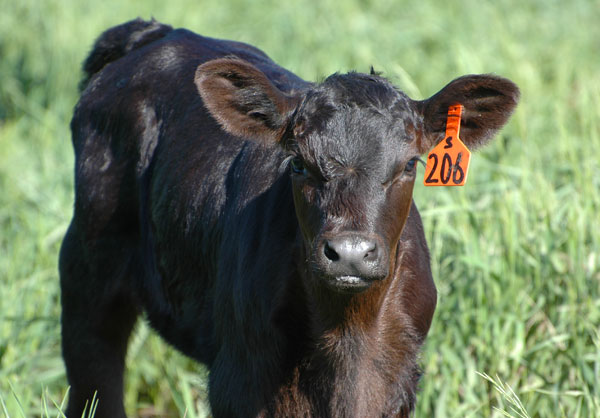Six-weight cattle near major grazing regions trade $6-$8 higher. Wholesale beef values climbed to record-high levels earlier in the week and then softened as cattle futures began showing some fatigue.
March 22, 2014

“Forward contracting of fall yearlings is already at a sizeable premium to current delivery sales and starting to hint that price levels could go much further,” analysts with the Agricultural Marketing Service (AMS) said Friday. “Purchasing of grazing cattle is at its peak and most cattle growers want to turn out a stocker big enough to be an 800-lb. yearling feeder by late summer or early fall.”
That helps explain how 6-weight cattle near the major grazing regions were able to charge ahead another $6-$8/cwt. while other parts of the market began showing some possible signs of wear.
Elsewhere, according to AMS, calf and stocker cattle prices were steady to $5/cwt. higher, while feeders weighing more than 800 lbs. sold weak to $2 lower with most of the decline in the Southern Plains.
After 42¢ higher in spot March, Feeder Cattle futures closed an average of $1.44 lower week-to-week.
Enjoy what you are reading? Subscribe to BEEF Daily for industry hot topics Monday-Thursday.
“There’s no doubt that feeder cattle prices are top-heavy and vulnerable for a tumble if a strong enough push comes along,” AMS analysts say. “Of all the factors that could be responsible for such a blow, dry weather is the most likely culprit. Early spring is always dry and windy in the Southern Plains, but the Texas Panhandle and surrounding areas are experiencing Dust Bowl-like dust storms. Farther north, the Midwest is still reeling from the brutally cold winter, but many areas (like Kansas and Nebraska) did not receive all that much measurable snow.”
Choice and Select boxed-beef cutout values achieved new record-high prices again this week at $244.06/cwt. and $237.19, respectively. Wholesale values softened some by the end of the week ($240.16 for Choice and $233.66 for Select) but at levels similar to the record-high plateau first established during January’s panic-buying, then re-established March 11.
“The price decline can be largely attributed to an increase in chain speeds and beef movement as cattle slaughter through Thursday was estimated to be about 16,000 head more than the previous week,” Andrew P. Griffith, University of Tennessee agricultural economist, explained in his market comments Friday. “Though the number of head harvested this week increased relative to a week ago, it is about 18,000 head fewer than the same week a year ago, which is indicative of total beef production and the strong wholesale beef cutout prices.”
Along with seasonality, Friday’s USDA Cold Storage report could offer some support. Beef in freezers at the end of February was 5% less than the previous month, and 17% less than the previous year. Total red meat supplies were 1% higher at the end of February compared to the previous month but 5% less than a year earlier.
Cash fed cattle sales were steady to $2 higher last week at $150/cwt. in the Southern Plains and mostly $152 in the Northern Plains. Dressed prices in Nebraska were steady to $2 higher at $240-$242.
Live Cattle futures closed an average of $1.15 lower week-to-week (50¢ to $1.97 lower).
It’s too soon to know how much the late-week softening in wholesale beef values and cattle futures have to do with market fatigue and how much was simply a result of re-positioning ahead of Friday’s Cattle on Feed (COF) report (see below) and the Prospective Plantings report due out March 31.
“Retreating feed costs have predictably triggered a surge in feeder cattle prices,” explained John Otte, Penton market analyst, Friday. “Adding surplus feedlot bunk space to the equation has feedlot managers grappling with how much they can pay for feeders, given expected fed cattle prices down the road that may or may not be as high as current deferred futures prices suggest.” Currently, though, he points out feedlots are finally in a position to make money.
“The feedlot will continue to hold a sliver of leverage over the packer for a few more weeks, but the leverage will soon disappear when a larger quantity of market-ready cattle hit show lists.,” Griffith says. “Packers will then find themselves in a favorable situation because of the need for feedlots to remain current in cattle marketings. The leverage will not be as great as in previous years due to low cattle numbers, but it will exist nevertheless.”
“The bearish report (COF) will likely be felt next week on the CME feeder cattle futures and perhaps in the cash market, but will most likely not be enough to extinguish the red-hot demand,” AMS analysts say.
More articles to enjoy:
Calving 101: How To Use A Calf Puller
Let’s Go Mudding! 15 New ATVs & UTVs for 2014
Forget Chipotle’s Negativity; Culver’s Champions Animal Ag
Kick Off Your Day With 80+ Photos Of Calves & Cowboys
I Love Tournament Time But I Hate Ranching’s March Madness
You May Also Like



